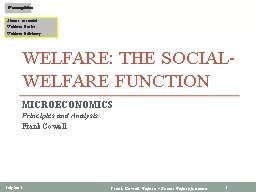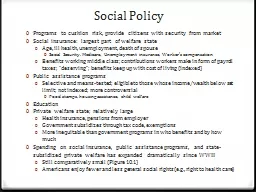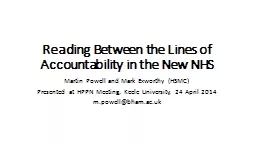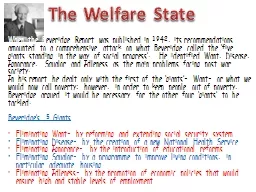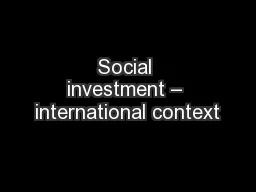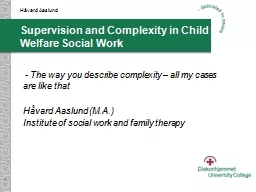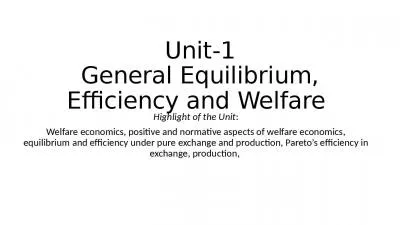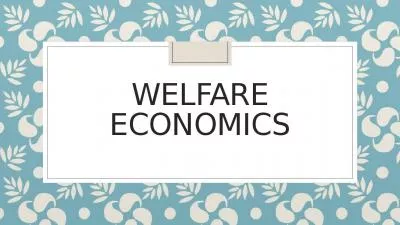PPT-Welfare: The Social-Welfare Function
Author : conchita-marotz | Published Date : 2016-08-11
MICROECONOMICS Principles and Analysis Frank Cowell Almost essential Welfare Basics Welfare Efficiency Prerequisites July 2015 1 Social Welfare Function Limitations
Presentation Embed Code
Download Presentation
Download Presentation The PPT/PDF document "Welfare: The Social-Welfare Function" is the property of its rightful owner. Permission is granted to download and print the materials on this website for personal, non-commercial use only, and to display it on your personal computer provided you do not modify the materials and that you retain all copyright notices contained in the materials. By downloading content from our website, you accept the terms of this agreement.
Welfare: The Social-Welfare Function: Transcript
MICROECONOMICS Principles and Analysis Frank Cowell Almost essential Welfare Basics Welfare Efficiency Prerequisites July 2015 1 Social Welfare Function Limitations of the welfare analysis so far. N. icamil K. Sanchez,. RSW, MPM, Dip. Ger.(Malta). PhD candidate. nksanc001@myacu.edu.au/nsan0001@um.edu.mt. Abstract id no: 2433644. Session . name: WS 131 Migration and the social worker I (3:3). Re. -institutionalisation of. Welfare Services in Turkey. Umut Korkut. Glasgow Caledonian University. Umut.korkut@gcu.ac.uk. Outline. De-centralisation and Re-centralisation of Welfare. Theoretical background. Catching up on . Conditionality. David Robinson. 25 . October 2013. Queen's University, Belfast. ESRC Seminar Series - . Localism. , Welfare Reform and Tenure Restructuring in the UK. focus = access to social housing in England. Programs to cushion risk, provide citizens with security from market. Social insurance: largest part of welfare state. Age, ill health, unemployment, death of spouse. Social Security, . Medicare, . Unemployment insurance, . ’. Martin Powell, . HSMC. , University of Birmingham. Presented at . SPA Conference, Sheffield . University, . 15 July 2014. m.powell@bham.ac.uk. Introduction. T. he . welfare modelling business is based on an unclear business strategy in that its conceptual criteria underpinning the ‘re-specification of the welfare state’ (. When the B. everidge Report was published in 1942, its recommendations amounted to a comprehensive attack on what Beveridge called the ‘five giants standing in the way of social progress’. He identified Want, Disease, Ignorance, Squalor and Idleness as the main problems facing post war society.. Dr Simon Chapple. AUT Policy Observatory & VUW. simon.chapple@vuw.ac.nz. What’s good and what’s not about “social investment” in NZ. Tomorrow matters, as well as today. Joined-up policy making across agencies. Paul Smyth. University of Melbourne. Pre history. Pre welfare state: . tawney. Myrdal Keynes . etc. Welfare state : T H Marshall . New Left: O’Connor Gough . Offe. New Right : . friedman. . hayek. Discretionary spending: Congress can adjust the amount spent on different programs through changes in annual appropriations bills.. Mandatory spending: the federal government is legally required to spend the money.. La gamme de thé MORPHEE vise toute générations recherchant le sommeil paisible tant désiré et non procuré par tout types de médicaments. Essentiellement composé de feuille de morphine, ce thé vous assurera d’un rétablissement digne d’un voyage sur . Jamal Wiwoho. Pujiyono. Triyanto. Sebelas Maret University . - Indonesia. International Conference on “Business, Economics, and Social Science & Humanities”- BESSH-. Manila 29-30 Oct . 2016. . - The way you describe complexity – all my cases are like that. Håvard. . Aaslund. (M.A.). Institute of social work and family therapy. Håvard. . Aaslund. 1. Outline. . of. . the. . presentation. Highlight of the Unit. :. Welfare economics, positive and normative aspects of welfare economics, equilibrium and efficiency under pure exchange and production, Pareto’s efficiency in exchange, production, . Welfare economics is concerned with the evaluation of alternative economic situations (states, configurations) from the point of view of the society’s well being. . Suppose the total welfare in a country is W, but given the factor endowments and...
Download Document
Here is the link to download the presentation.
"Welfare: The Social-Welfare Function"The content belongs to its owner. You may download and print it for personal use, without modification, and keep all copyright notices. By downloading, you agree to these terms.
Related Documents

